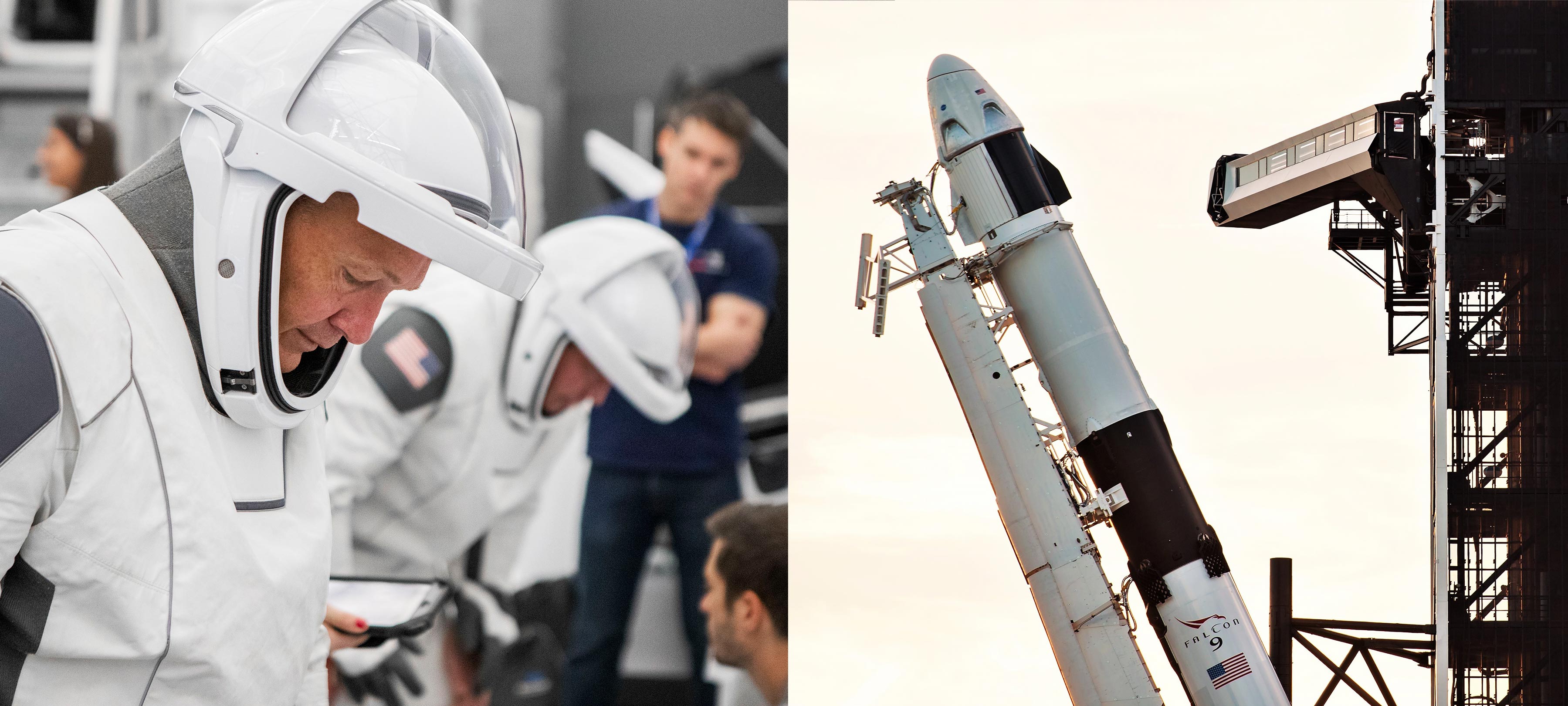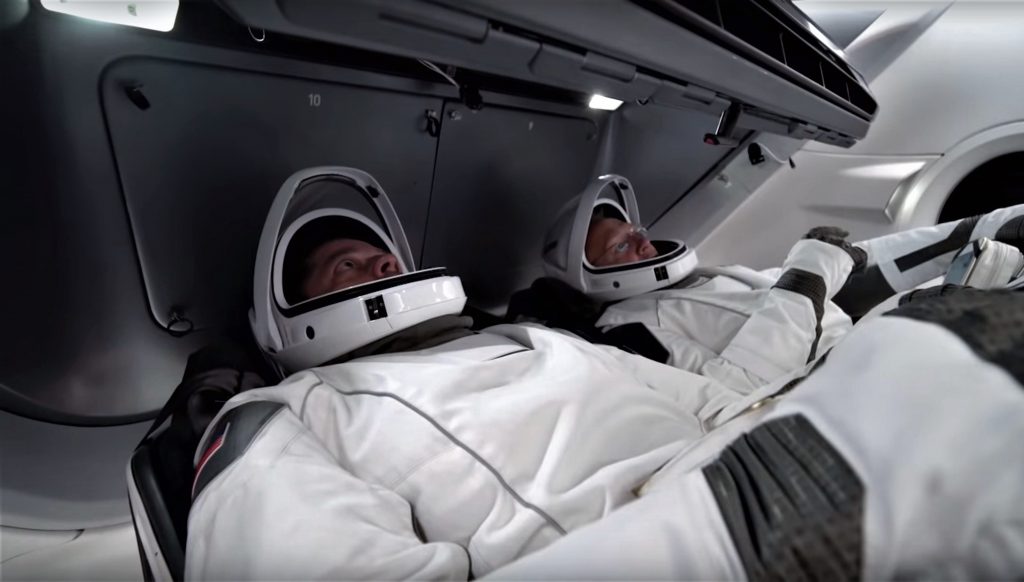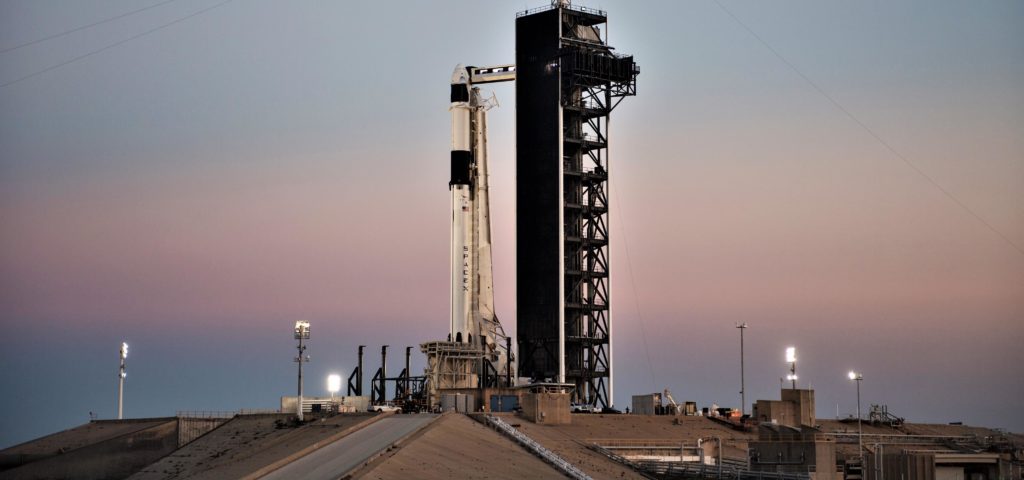

News
SpaceX’s first Crew Dragon NASA astronauts suit up for spacesuit-focused launch rehearsal
While a great deal of work remains before SpaceX and NASA are ready to set a date for Crew Dragon’s inaugural astronaut launch (Demo-2) both teams continue to actively prepare for the milestone mission.
Most recently, NASA has published photos detailing a critical (and literal) dress rehearsal with astronauts Col. Bob Behnken and Col. Doug Hurley, set to become the first astronauts to ride SpaceX’s Crew Dragon to orbit and dock with the International Space Station (ISS). This particular test centered around the process of suiting up in SpaceX’s iconic, custom-built spacesuits and simulated pre-launch procedures in a Crew Dragon simulator located at SpaceX’s Hawthorne, CA headquarters.
A literal dress rehearsal
On Thursday, an official NASA Astronaut account tweeted that SpaceX’s first two Commercial Crew astronauts had recently completed a dress rehearsal test of the spacesuits that they will wear during Crew Dragon’s inaugural crewed launch to the ISS. Bob Behnken and Doug Hurley participated in a full “suit-up & leak checks” rehearsal with their iconic SpaceX-built suits and the same Ground Support Equipment (GSE) hardware that will be used during Demo-2. This dress rehearsal also serves to familiarize the SpaceX and NASA ground support crew with the astronaut suit-up process, and multiple technicians and flight engineers are visible in the background.
The new spacesuits made their press debut last summer at a media event held at SpaceX headquarters in Hawthorne, California. Not only are they uniquely beautiful and modernist, but SpaceX’s spacesuits are also designed first and foremost with functionality in mind. SpaceX hired its own team of seamstresses and focused heavily on integrating 3D printing into suit production, resulting in an end-product that is simultaneously strikingly minimalistic and extremely usable. For example, the helmets Behnken and Hurley are seen wearing use 3D printing to integrate extremely complex life support systems, a built-in microphone and speaker communications array, a seamless multi-hinged visor, and more.


The suits are also designed to allow for easy maneuverability and a seamless user experience within the Dragon capsule. The attached gloves of the suit use conductive leather to allow the astronauts to interact with the Crew Dragon’s primary controls, a set of large touchscreens. Apple iPads will additionally be mounted directly on the thighs of the astronauts to serve as an even more convenient (and redundant) method of interfacing with Dragon’s controls, among other things.
While the suits are designed to be pressurized to support the astronauts in the event of a life-threatening event that may occur aboard Dragon, they are not meant for spacewalks or prolonged exposure to the vacuum of space.

Behnken, Hurley, and other Commercial Crew astronauts have been included in the development of their suits since day one and each flight suit has been carefully tailored to fit each future Crew Dragon astronaut. Having the opportunity to run through a launch day dress rehearsal allows everyone in the process to become familiarized with the specialized procedures that will occur ahead of boarding the Dragon capsule.
Crew Dragon sidesteps the norm
Unlike previous crewed NASA launches, SpaceX plans to have astronauts board Crew Dragon before launch vehicle fueling begins. This new approach to crew loading has become known as “Load-and-Go.” This procedure is extremely familiar to SpaceX, as the company supercools the liquid oxygen and kerosene propellant used by Falcon 9 and Heavy to significantly improve the performance of both rockets.
SpaceX has made the rational argument that boarding astronauts before fueling is actually significantly safer than the traditional method of ingressing astronauts while the rocket is fully fueled. Once inside Crew Dragon, the spacecraft’s SuperDraco abort system would be armed, theoretically protecting its astronauts from any conceivable explosion-related vehicle failure, whereas a fueled rocket failing during ingress could easily kill anyone in close proximity for the boarding procedure.

According to NASA, possible dates for Crew Dragon’s Demo-2 astronaut launch debut are under review. In a mid-July conference call with SpaceX and NASA officials, neither were particularly confident that Demo-2 would be ready to launch before the end of 2019, although they specifically did not rule the possibility out. More likely than not, Crew Dragon Demo-2 will slip into early 2020 as a result of a catastrophic explosion that destroyed Crew Dragon capsule C201 during static fire testing earlier this year.
Check out Teslarati’s Marketplace! We offer Tesla accessories, including for the Tesla Cybertruck and Tesla Model 3.
News
Tesla cleared in Canada EV rebate investigation
Tesla has been cleared in an investigation into the company’s staggering number of EV rebate claims in Canada in January.

Canadian officials have cleared Tesla following an investigation into a large number of claims submitted to the country’s electric vehicle (EV) rebates earlier this year.
Transport Canada has ruled that there was no evidence of fraud after Tesla submitted 8,653 EV rebate claims for the country’s Incentives for Zero-Emission Vehicles (iZEV) program, as detailed in a report on Friday from The Globe and Mail. Despite the huge number of claims, Canadian authorities have found that the figure represented vehicles that had been delivered prior to the submission deadline for the program.
According to Transport Minister Chrystia Freeland, the claims “were determined to legitimately represent cars sold before January 12,” which was the final day for OEMs to submit these claims before the government suspended the program.
Upon initial reporting of the Tesla claims submitted in January, it was estimated that they were valued at around $43 million. In March, Freeland and Transport Canada opened the investigation into Tesla, noting that they would be freezing the rebate payments until the claims were found to be valid.
READ MORE ON ELECTRIC VEHICLES: EVs getting cleaner more quickly than expected in Europe: study
Huw Williams, Canadian Automobile Dealers Association Public Affairs Director, accepted the results of the investigation, while also questioning how Tesla knew to submit the claims that weekend, just before the program ran out.
“I think there’s a larger question as to how Tesla knew to run those through on that weekend,” Williams said. “It doesn’t appear to me that we have an investigation into any communication between Transport Canada and Tesla, between officials who may have shared information inappropriately.”
Tesla sales have been down in Canada for the first half of this year, amidst turmoil between the country and the Trump administration’s tariffs. Although Elon Musk has since stepped back from his role with the administration, a number of companies and officials in Canada were calling for a boycott of Tesla’s vehicles earlier this year, due in part to his association with Trump.
News
Tesla Semis to get 18 new Megachargers at this PepsiCo plant
PepsiCo is set to add more Tesla Semi Megachargers, this time at a facility in North Carolina.

Tesla partner PepsiCo is set to build new Semi charging stations at one of its manufacturing sites, as revealed in new permitting plans shared this week.
On Friday, Tesla charging station scout MarcoRP shared plans on X for 18 Semi Megacharging stalls at PepsiCo’s facility in Charlotte, North Carolina, coming as the latest update plans for the company’s increasingly electrified fleet. The stalls are set to be built side by side, along with three Tesla Megapack grid-scale battery systems.
The plans also note the faster charging speeds for the chargers, which can charge the Class 8 Semi at speeds of up to 1MW. Tesla says that the speed can charge the Semi back to roughly 70 percent in around 30 minutes.
You can see the site plans for the PepsiCo North Carolina Megacharger below.

Credit: PepsiCo (via MarcoRPi1 on X)

Credit: PepsiCo (via MarcoRPi1 on X)
READ MORE ON THE TESLA SEMI: Tesla to build Semi Megacharger station in Southern California
PepsiCo’s Tesla Semi fleet, other Megachargers, and initial tests and deliveries
PepsiCo was the first external customer to take delivery of Tesla’s Semis back in 2023, starting with just an initial order of 15. Since then, the company has continued to expand the fleet, recently taking delivery of an additional 50 units in California. The PepsiCo fleet was up to around 86 units as of last year, according to statements from Semi Senior Manager Dan Priestley.
Additionally, the company has similar Megachargers at its facilities in Modesto, Sacramento, and Fresno, California, and Tesla also submitted plans for approval to build 12 new Megacharging stalls in Los Angeles County.
Over the past couple of years, Tesla has also been delivering the electric Class 8 units to a number of other companies for pilot programs, and Priestley shared some results from PepsiCo’s initial Semi tests last year. Notably, the executive spoke with a handful of PepsiCo workers who said they really liked the Semi and wouldn’t plan on going back to diesel trucks.
The company is also nearing completion of a higher-volume Semi plant at its Gigafactory in Nevada, which is expected to eventually have an annual production capacity of 50,000 Semi units.
Tesla executive teases plan to further electrify supply chain
News
Tesla sales soar in Norway with new Model Y leading the charge
Tesla recorded a 54% year-over-year jump in new vehicle registrations in June.

Tesla is seeing strong momentum in Norway, with sales of the new Model Y helping the company maintain dominance in one of the world’s most electric vehicle-friendly markets.
Model Y upgrades and consumer preferences
According to the Norwegian Road Federation (OFV), Tesla recorded a 54% year-over-year jump in new vehicle registrations in June. The Model Y led the charge, posting a 115% increase compared to the same period last year. Tesla Norway’s growth was even more notable in May, with sales surging a whopping 213%, as noted in a CNBC report.
Christina Bu, secretary general of the Norwegian EV Association (NEVA), stated that Tesla’s strong market performance was partly due to the updated Model Y, which is really just a good car, period.
“I think it just has to do with the fact that they deliver a car which has quite a lot of value for money and is what Norwegians need. What Norwegians need, a large luggage space, all wheel drive, and a tow hitch, high ground clearance as well. In addition, quite good digital solutions which people have gotten used to, and also a charging network,” she said.
Tesla in Europe
Tesla’s success in Norway is supported by long-standing government incentives for EV adoption, including exemptions from VAT, road toll discounts, and access to bus lanes. Public and home charging infrastructure is also widely available, making the EV ownership experience in the country very convenient.
Tesla’s performance in Europe is still a mixed bag, with markets like Germany and France still seeing declines in recent months. In areas such as Norway, Spain, and Portugal, however, Tesla’s new car registrations are rising. Spain’s sales rose 61% and Portugal’s sales rose 7% last month. This suggests that regional demand may be stabilizing or rebounding in pockets of Europe.
-

 Elon Musk2 weeks ago
Elon Musk2 weeks agoTesla investors will be shocked by Jim Cramer’s latest assessment
-

 Elon Musk2 days ago
Elon Musk2 days agoxAI launches Grok 4 with new $300/month SuperGrok Heavy subscription
-

 Elon Musk4 days ago
Elon Musk4 days agoElon Musk confirms Grok 4 launch on July 9 with livestream event
-

 News1 week ago
News1 week agoTesla Model 3 ranks as the safest new car in Europe for 2025, per Euro NCAP tests
-

 Elon Musk2 weeks ago
Elon Musk2 weeks agoA Tesla just delivered itself to a customer autonomously, Elon Musk confirms
-

 Elon Musk1 week ago
Elon Musk1 week agoxAI’s Memphis data center receives air permit despite community criticism
-

 News2 weeks ago
News2 weeks agoXiaomi CEO congratulates Tesla on first FSD delivery: “We have to continue learning!”
-

 Elon Musk1 week ago
Elon Musk1 week agoTesla scrambles after Musk sidekick exit, CEO takes over sales



















